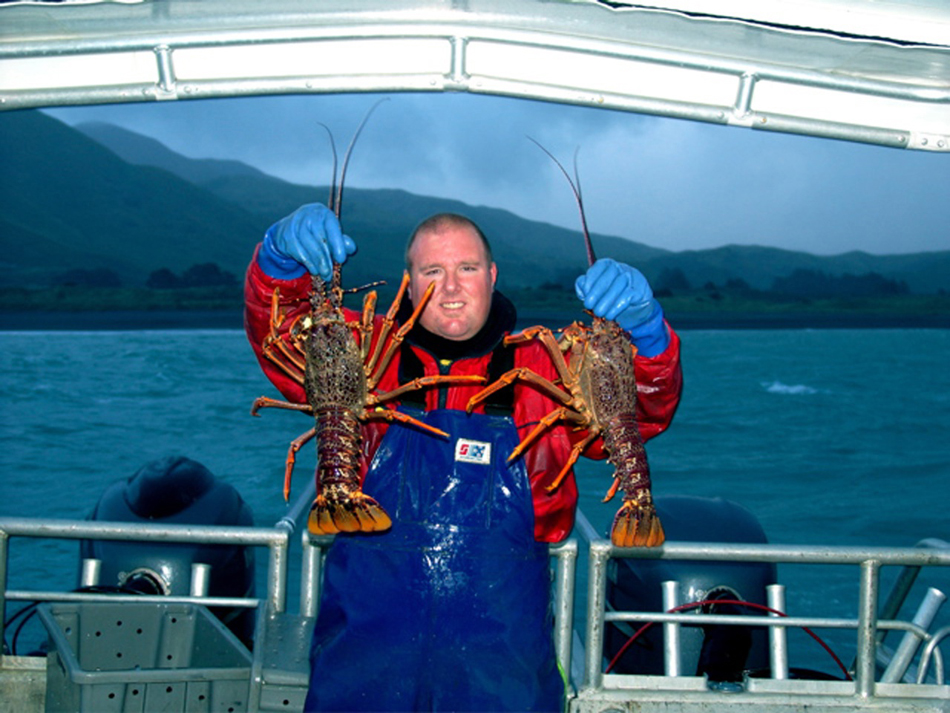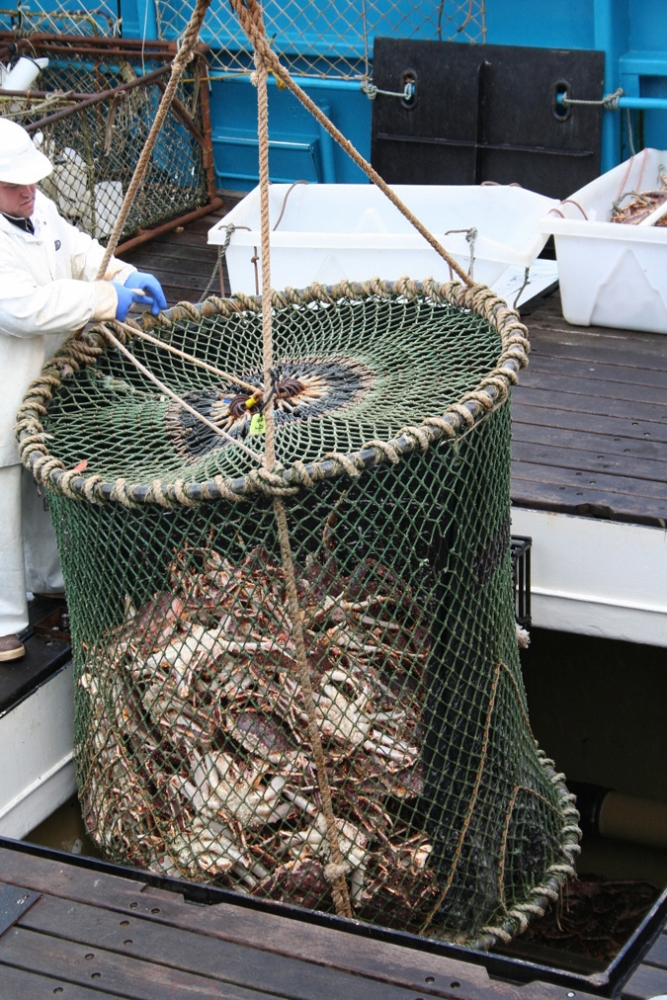New Study by UCSB, Hawaii Scientists Offers Solution to Global Fisheries Collapse



A study published in the September 19 issue of Science shows that an innovative yet contentious fisheries management strategy called "catch shares" can reverse fisheries collapse. Where traditional "open access" fisheries have converted to catch shares, both fishermen and the oceans have benefited.
UC Santa Barbara scientists Christopher Costello and Steven Gaines are two of the co-authors of this groundbreaking study, which was funded by the Paul G. Allen Family Foundation. Costello, the lead author, is an economist at the Bren School of Environmental Science and Management at UCSB. Gaines is director of UCSB's Marine Science Institute. John Lynham, assistant professor at the University of Hawaii, is the third author.
"Our data, from over 11,000 fisheries worldwide, suggest that catch shares may be a powerful tool to overcome the widespread decline in global fisheries," Costello says.
Catch shares are common in New Zealand, Australia, Iceland, and increasingly the United States and Canada. They guarantee each shareholder a fixed portion of a fishery's total allowable catch, which is set each year by scientists. Much like stock shares in a corporation, these shares can be bought and sold. Each share becomes more valuable when the fish population – and thus the total allowable catch – increases. With catch shares, every shareholder has a financial stake in the long-term health of the fishery.
The results of the study are striking: While nearly a third of open-access fisheries have collapsed, the number is only half that for fisheries managed under catch share systems.
Furthermore, the authors show that catch shares reverse the overall downward trajectory for fisheries worldwide, and that this beneficial effect strengthens over time.
"Under open access, you have a free-for-all race-to-fish, which ultimately leads to collapse," says Costello.
"But when you allocate shares of the catch, then there is an incentive to protect the stock-which reduces collapse. We saw this across the globe. It's human nature."
The results of this study are certain to have wide-ranging implications as more fisheries in the United States, Canada, Mexico, and elsewhere consider switching to catch shares systems. It is particularly timely for the West Coast of the United States, where the groundfish fishery – which encompasses more than 80 species including sole, rockfish (snapper), hake, and sablefish (Alaskan black cod) – is likely to transition to catch shares. This paper provides the first global evidence that catch shares lead to better biological outcomes, and contributes an important scientific basis to the discussions. The Pacific Fisheries Management Council, which manages the groundfish fishery on the West Coast, will make their final decision during the week of November 2, 2008.
Gaines, Costello, and Lynham say they are extremely grateful for the support of Allen and his foundation. Without their generous support, this important project couldn't have happened, they say.
"Mr. Allen is passionate about the ocean," Gaines says. "The global declines in ocean health have prompted him and his foundation to support the search for innovative solutions using market-based approaches."
Peter Berliner, program director for the Paul G. Allen Family Foundation, says "the Foundation was looking for a way to improve and sustain the health of the oceans. UCSB provided the expertise and knowledge to demonstrate a way of helping our oceans and preserving the economic viability of an industry."
This new study offers hope that fisheries can resist the widespread global collapse projected two years ago by Boris Worm of Dalhousie University, Halifax and colleagues. In fact, the current work uses the same dataset that Worm et al. based their projection on – a global database of fisheries from the Sea Around Us Project that spans the years 1950-2003.
The authors of the present study were motivated by that paper to investigate possible solutions. Their analysis suggests that we already have the tools to reverse the current global fisheries crisis.
"Previous papers, including my own, have relied on small samples from the world's fisheries. The great thing about this paper is they have made an attempt to find all the fisheries in the world that have used dedicated access and evaluate the consequences," says Ray Hilborn, a leading fisheries scientist at the University of Washington who was not involved in the study. "The field has now moved beyond listing failures in fisheries. Ecology and economics do not need to collide; win-win solutions have been found."
While the current study focuses on Individual Transferable Quotas (ITQs), which are a type of catch share, Costello and his co-authors note that to maximize benefits, catch shares must be tailored to the ecological, economic, and social characteristics of a fishery.
If designed properly, catch share programs can reduce bycatch – the unintentional harvest of threatened or undesirable species – and protect the ecosystem in the process. By imposing individual limits on bycatch, as well as on desirable species, catch shares create incentives to develop environmentally beneficial new technologies, such as more selective, less damaging fishing gear.
"The difference is comparable to renting an apartment versus the house you own," says Costello.
"If you own something, you take care of it––you protect your investment or else it loses value. But there's no incentive for stewardship when you don't own the rights to it."
The Alaskan halibut fishery is a prime example of success. In 1995, when the fishery converted to ITQs, the total season had dwindled from about four months down to just two or three days. These dangerous sprints resulted in boats with their holds crammed full of frozen fish; by the time the overloaded processing facilities could accommodate them, quality had suffered. Today, the season lasts nearly eight months. Because boats now haul in fresh, undamaged fish in manageable quantities, the per-pound price has increased significantly.
"Halibut fishermen were barely squeaking by – but now the fishery is insanely profitable," says Gaines.
The authors emphasize that for all their strengths, catch shares are not a panacea. Strategies vary widely, and must be carefully designed and continually fine-tuned to meet the goals of the ecosystems, economies and societies they are meant to serve. Controls such as consolidation caps, which prevent any one entity from owning too much of a given fishery, and community-owned quotas have worked in some cases to help maintain vibrant ports and fisheries. Some design features, however, such as how shares are allocated between individuals and processors, can be contentious, as in the Alaskan king crab fishery and elsewhere.
"One of the big challenges in catch shares is how you allocate the shares," Gaines explains. "But this is not a scientific question; it's a value judgment on the part of local communities and their governments."
Overall, the current study scientifically affirms what some fishermen and fisheries managers have long suspected based on anecdotal evidence and firsthand observation.
"Up until now, it's been an article of faith. It's pleasing to see that the data really does show these trends," says Jeremy Prince, a fisheries scientist and former fisherman from Australia who is a leader in transitioning fisheries to catch shares.
"This study gives us a solution to work with in fighting the global fishery crisis," says Boris Worm, who was not involved in the research. "There are fisheries which are doing well because of rights-based management. It's the silver lining that we have been looking for. Now we need to implement these solutions more widely."
Catch shares are not a one-size-fits-all solution. However, the current study demonstrates that ownership can be a powerful ally in the effort to reverse fisheries decline, especially when deployed with complementary management strategies. With proper design, careful monitoring, and real-time adaptation to changing environmental conditions, catch shares can help ensure that the world will enjoy plentiful seafood for years to come.
About the Paul G. Allen Family Foundation
Through the consolidation in 2004 of philanthropist Paul G. Allen's six private foundations (first established in 1988), the Paul G. Allen Family Foundation supports nonprofit organizations focused on making positive and measurable change. The Foundation's vision for transforming lives and building healthy communities guides its four priority program areas for funding, which include nurturing the arts, engaging children in learning, addressing the needs of vulnerable populations and advancing scientific and technological discoveries. For more information, visit the Foundation online at www.pgafamilyfoundation.org.
† Top photo: Photo credit: Abigail Powell
Anchovy is one of 68 fisheries managed under Individual Transferable Quotas (ITQs) on the New Zealand Shelf
†† Middle photo: Photo credit: Daryl Sykes, copyright New Zealand Rock Lobster Industry Council
A New Zealand-based fisherman shows off two large rock lobsters. This fishery has been managed under ITQs since 1990.
††† Bottom photo: Photo credit: Valerie Craig, Marine Photobank
Emptying a trap of Alaskan king crab. The transition of this fishery to ITQs in 2005 consolidated the fleet and reduced the "race to fish, but created contention over share allocations.
Related Links



